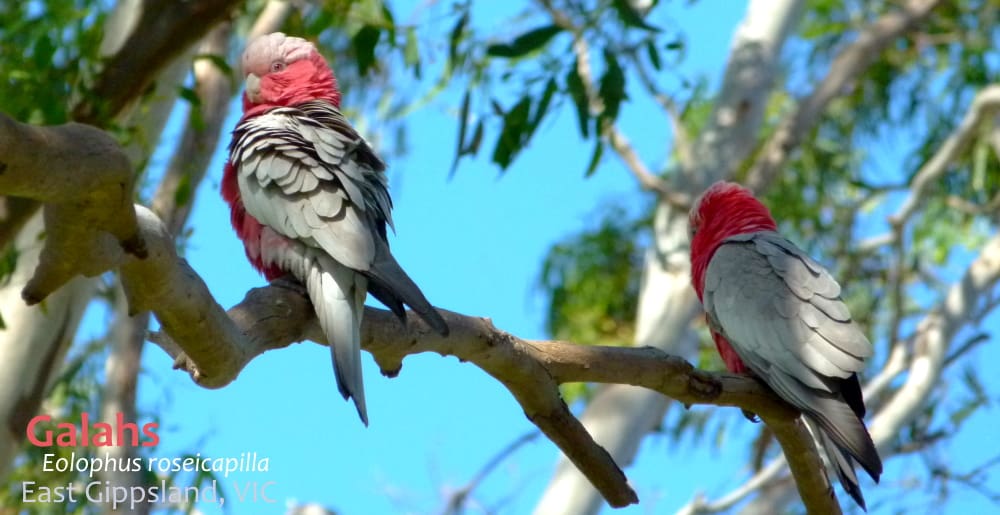In East Gippsland on the Wildlife Journey tour we often see Galahs near the Snowy River at Orbost, where we stay at the Snowy River Homestead.
The Galah Eolophus roseicapilla is sometimes known overseas, and in the pet trade, as the Rose-breasted Cockatoo. But in Australia we call them Galahs.

Here are 5 amazing facts about the Galah that you may not know.
..
1. Galahs help with seed dispersal
Galahs are seed-eaters, so are often seen feeding on grass seeds on the ground. They also eat seeds from many Australian shrubs and trees, including Acacias (Wattles) and Casuarinas (She-oak). They are important seed dispersers – many seeds germinate after galahs carry them to another site, and then drop them intact or partially-eaten.

..
2. Huge flocks of pink Galahs
Galahs can travel and roost in flocks of 1000 birds. It is an impressive sight, especially at dawn and sunset – their bright pink breasts glow in the warm light.
Galahs are very fast – they are known to fly at 70km/hr. They are powerful and acrobatic, and think nothing of doing loop-the-loops, and ducking through branches at speed, all in a show of their aerial mastery. To see a huge flock of galahs flying like daredevils, high and low, at great speed, is one of the great sights of Australia.

..
3. Loving families
Galah pairs share the nesting and parenting duties of their offspring, and baby Galahs stay with their parents for months or years. Galahs are monogamous and mate for life. The male Galah chirps and screeches in an effort to impress the female while courting. Galahs make their nests in hollow parts of trees – in spring it is not uncommon to see adult galahs entering or renovating hollows.


..
A sad side to this story:
..
4. Pink for Girls
You can tell a female Galah by the colour of her eyes: just remember “pink for girls”. Female galahs have pink eyes. Males and young birds have dark brown eyes.
Many Australian cockatoos and parrots are colourful – read about red-and-green King Parrots here.

..
5. Aboriginal Origin of the word Galah
Galah (gilaa) is the bird’s Yuwaalaraay Aboriginal language name. The Yuwaalaraay are a tribe from northern New South Wales, around the area of Lightning Ridge.

..
The word galah is also used in Australia for a silly person, a bit of a clown. This is thought to have come from the silly antics of Galah birds. Though highly intelligent, galahs often play the fool – hanging upside-down on branches, sliding down wires, tumbling and wrestling each other on the ground, doing somersaults and playing with toys. Watch:
See Galahs on the Wildlife Journey in East Gippsland, Australia.
..
NOTES & REFERENCES:
See more about Australian Galahs at these links:
BirdLife Australia fact sheet: https://www.birdlife.org.au/bird-profile/galah
Australian Museum fact sheet: https://australianmuseum.net.au/learn/animals/birds/galah/
Parrots.org: https://www.parrots.org/encyclopedia/galah
……………………………….
Contact us
Echidna Walkabout Nature Tours
T: +613 9646 8249
Fax: +613 9681 9177
E: enquiries@echidnawalkabout.com.au

